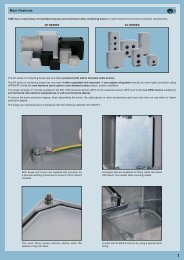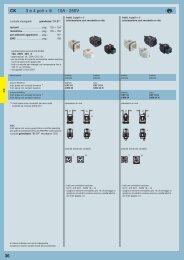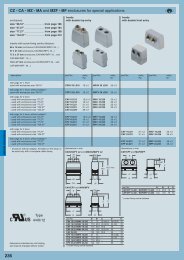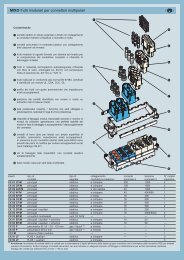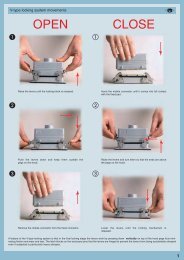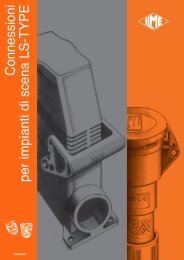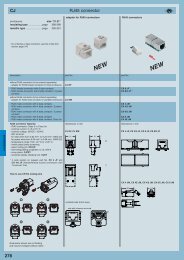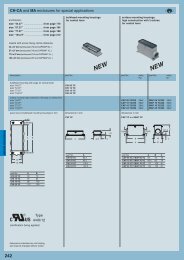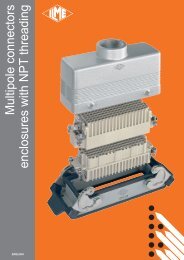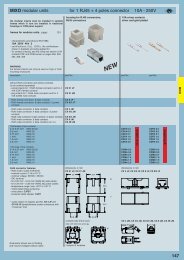standardsstandardsDimensioning of clearances and creepage distancesEuropean standard EN 61984 Ed. 1.0 (22001-11) was recently publishedfor safety prescriptions for multipole connec<strong>to</strong>rs for industrial uses and for<strong>the</strong> relevant tests. This standard assimilates, without any modifications, <strong>the</strong>corresponding international standard IEC 61984 Ed.1.0 (2001-06).It is applicable <strong>to</strong> connec<strong>to</strong>rs with rated voltage values of over 50V, and up<strong>to</strong> 1000V, and rated currents values of up <strong>to</strong> 125A per pole, for which nodedicated standard exists, or <strong>to</strong> which <strong>the</strong> particular specifications or <strong>the</strong>manufacturer refer as regards <strong>the</strong> safety aspects.For determining <strong>the</strong> minimum through-air and surface insulation distances,i.e. creepage distances, for connec<strong>to</strong>rs, this standard makes use (with somemodifications) of <strong>the</strong> concepts of standard IEC 60664-1 Ed. 1.0 (1992-10) 1) .NOTE - For connec<strong>to</strong>rs with rated voltage values of up <strong>to</strong> 50V - excludedfrom <strong>the</strong> field of application of Low Voltage Directive 73/23/EEC - standardEN 61984 may be used as a guide. For surface and through-air insulationdistances, refer <strong>to</strong> standard IEC 60664-1 Ed. (1992-10).We are illustrating below <strong>the</strong> method of standard EN 61984 for determiningminimum insulation values in connec<strong>to</strong>rs. The rated characteristics for eachILME connec<strong>to</strong>r family are provided on pages 14 and 15.The following are now obsolete: <strong>the</strong> insulation group concept, and <strong>the</strong>distinction of rated voltage values in<strong>to</strong> d.c. and a.c. voltage values 220Vand 380V were adapted <strong>to</strong> standardised values 230V and 400V according<strong>to</strong> IEC 60038 (2) and some concepts were taken from <strong>the</strong> regulations for LVelectrical systems of <strong>the</strong> IEC 60364 (3) series, as follows:- The overvoltage categories (I, II, III, IV), according <strong>to</strong> <strong>the</strong> use of <strong>the</strong>equipment (4) . They are correlated <strong>to</strong> <strong>the</strong> transient overvoltages taken as abasis for determining <strong>the</strong> rated impulse withstand voltage- The degrees of pollution- The classification of insulating materials according <strong>to</strong> <strong>the</strong>ir resistance <strong>to</strong>tracking- The conditions of <strong>the</strong> electrical field (homogenous or inhomogenous).Overvoltage categories (or impulse withstand)The overvoltage categories of a circuit or of an electrical system areidentified by a conventional number (from I <strong>to</strong> IV) based on <strong>the</strong> limit or <strong>the</strong>control of <strong>the</strong> assumed transient overvoltage values obtained on a circuit orelectrical system and depends on <strong>the</strong> means used <strong>to</strong> reduce <strong>the</strong>overvoltages.TABLE 1The rated impulse withstand voltage for equipment energised directly from<strong>the</strong> low-voltage mains (IEC 60664-1 Edition 1.0 1992-10)Nominal voltage of Voltage line <strong>to</strong> neutral Rated impulse withstand<strong>the</strong> supply system derived from nominal voltage b)based on IEC 60038 voltages a.c. or d.c.(CENELEC HD 472 S1, CEI 8-6)Overvoltage categoryV V ≤ V VThree phase a) Single phase I II III IV50 330 500 800 1500100 500 800 1500 2500120-240 150 800 1500 2500 4000230/400277/480} 300 1500 2500 4000 6000400 / 690 600 2500 4000 6000 80001000 1000 4000 6000 8000 12000a) The "/" symbol indicates a four-wire three phase distribution system (star distribution).The lower value is <strong>the</strong> voltage between phase and neutral (phase voltage), whereas <strong>the</strong>higher value is <strong>the</strong> voltage between <strong>the</strong> phases (mains voltage).Where only one value is indicated, it refers <strong>to</strong> three-wire, three-phase systems (deltadistribution) and specifies <strong>the</strong> line-<strong>to</strong>-line value.b) Equipment with <strong>the</strong>se rated impulse withstand values can be used in installations inaccordance with standard IEC 60364-4-443 (Italian standard CEI 64-8/4 Section 443, Germanstandard DIN VDE 0100-443).Table 1 supplies <strong>the</strong> rated impulse withstand voltage for equipment energiseddirectly from <strong>the</strong> low voltage mains in function of <strong>the</strong> rated voltage of <strong>the</strong> powersupply system, <strong>the</strong> relative voltage line-<strong>to</strong>-neutral and <strong>the</strong> overvoltage category.Industrial machinery and installations with fixed connection <strong>to</strong> <strong>the</strong> lowvoltage supply system and consequently <strong>the</strong> relative componentsincluding multipole connec<strong>to</strong>rs, constitute an example of <strong>the</strong> equipmentthat belongs <strong>to</strong> <strong>the</strong> overvoltage category III.Examples of general equipment that comes under overvoltage categoryII are electrical household appliances, portable <strong>to</strong>ols and o<strong>the</strong>r householdequipment or similar.For distribution networks with rated voltage of 230/400V (star distribution wi<strong>the</strong>ar<strong>the</strong>d neutral), and over-voltage category III (category III: impulse withstanding),<strong>the</strong> demanded rated impulse withstanding voltage is 4kV.For distribution networks with rated voltage of 400 or 500V (star distributionwithout neutral or with insulated neutral, or delta distribution, insulated orcorner-ear<strong>the</strong>d), and over-voltage category III (category III: impulse withstanding),<strong>the</strong> demanded rated impulse withstanding voltage is 6kV.(1) Assimilated with modifications as European Harmonisation Document HD 625.1 S1:1996and published by <strong>the</strong> CENELEC member countries as a national standard: Italian standardCEI 28-6 (1997-11), German standard DIN VDE 0110-1 (VDE 0110 Teil 1):1997-04.(2) Harminisation Document CENELEC HD 472 S1, Italian standard CEI 8-6, Germanstandard DIN IEC 38:1987-05.(3) Italian standard CEI 64-8, German standard DIN VDE 0100.(4) HD 625.1 S1 modifies <strong>the</strong> definition <strong>to</strong> "impulse withstanding categories".Degrees of pollutionPollution indicates <strong>the</strong> presence of any kind of foreign matter, whe<strong>the</strong>r solid,liquid or gaseous (ionised gas) that can have a negative influence on <strong>the</strong>dielectric strength or on <strong>the</strong> surface resistivity of <strong>the</strong> insulating material.The standard establishes four degrees of pollution. The categories areidentified by conventional numbers based on <strong>the</strong> quantity of pollutingagents or on <strong>the</strong> frequency of <strong>the</strong> phenomenon which determines <strong>the</strong>reduction of <strong>the</strong> dielectric strength and/or of <strong>the</strong> surface resistivity.Pollution degree 1:No pollution or only dry, non-conductive pollution.The pollution has no influence.Pollution degree 2:Only non-conductive pollution except that occasionally a temporaryconductivity caused by condensation may occur.Pollution degree 3:Conductive pollution or dry, non-conductive pollution which becomesconductive due <strong>to</strong> condensation which may occur.Pollution degree 4:The pollution generates persistent conductivity caused by conductive dus<strong>to</strong>r by rain or snow.Pollution degree 3 is typical of an industrial environment or similar, whilepollution degree 2 is typical of a household environment or similar.Standard EN 61984 permits <strong>the</strong> sizing of surface insulation distances ofconnec<strong>to</strong>rs installed in enclosures in protection class ≥IP54 for <strong>the</strong> degreeof pollution immediately below that of <strong>the</strong> application environment (e.g.: 2instead of 3).Extract from standard EN 619846.19.2.2 For a connec<strong>to</strong>r in protection class IP54 or higher, according <strong>to</strong>Publication IEC 60529, <strong>the</strong> insulating parts inside <strong>the</strong> enclosure may besized for a lower degree of pollution.This applies also <strong>to</strong> coupled connec<strong>to</strong>rs, closure of which is ensured by <strong>the</strong>connec<strong>to</strong>r enclosure, and which may be uncoupled for test and maintenancepurposes only.One may <strong>the</strong>refore use connec<strong>to</strong>rs installed in enclosures or containers inprotection class ≥IP54, at <strong>the</strong> rated data referring <strong>to</strong> degree pollution 2 inindustrial applications with degree of pollution 3, if, in compliance with <strong>the</strong>standard, <strong>the</strong> coupling of <strong>the</strong> connec<strong>to</strong>rs is opened only occasionally fortests or maintenance. In <strong>the</strong> event of temporary or limited duration inuncoupled state, a closing cover is, however, necessary, guaranteeing atleast protection class IP54. However, this does not apply <strong>to</strong> connec<strong>to</strong>rswhich remain uncoupled and exposed <strong>to</strong> an industrial atmosphere for anindefinite period. It should be noted, however, that pollution could penetrateinside coupled connec<strong>to</strong>rs, also when it comes from remote parts of <strong>the</strong>electrical system (e.g. through conduits providing cable entry <strong>to</strong> <strong>the</strong>connec<strong>to</strong>rs enclosure).Moreover, connec<strong>to</strong>r enclosures are usually supplied without cable entrydevices, with <strong>the</strong> installer fitting such devices according <strong>to</strong> need. Thedegree of protection marked on <strong>the</strong> enclosures is guaranteed only forconnec<strong>to</strong>rs coupled through <strong>the</strong> use of cable entry devices in equal orhigher IP protection class and expertly installed.Examples of application for <strong>the</strong> selection of degree of pollution 2 fora connec<strong>to</strong>r- connec<strong>to</strong>r on an electric mo<strong>to</strong>r controller, which is uncoupled only <strong>to</strong> replacea faulty mo<strong>to</strong>r, also in cases where degree of pollution 3 is insteadspecified for <strong>the</strong> system;- connec<strong>to</strong>r on a module-constructed machine, which is opened only fortransport purposes and which is used only for faster installation and forsafer putting in<strong>to</strong> service. One must make sure that <strong>the</strong> connec<strong>to</strong>r has notbeen polluted during transport. To ensure this has not occurred, protectivecovers or adequate packing must be used;- connec<strong>to</strong>r inside a panel in protection class ≥IP54. In this case one mayeven renounce equipping <strong>the</strong> connec<strong>to</strong>r with an IP54 enclosure.Insulating materialInsulating material influences <strong>the</strong> determination of <strong>the</strong> minimum creepagedistance. It is characterised according <strong>to</strong> <strong>the</strong> damage it suffers from <strong>the</strong>concentrated release of energy during scintillations when a surface leakagecurrent is interrupted due <strong>to</strong> <strong>the</strong> drying of <strong>the</strong> contaminated surface.The CTI (comparative tracking index), (index of resistance <strong>to</strong> surfacecurrents) is assumed as index of <strong>the</strong> resistance <strong>to</strong> creep currents of <strong>the</strong>insulating materials in <strong>the</strong> presence of atmospheric contaminating agents.The CTI constitutes <strong>the</strong> numeric value of <strong>the</strong> maximum voltage at which amaterial can resist against 50 drops of an electrolytic test solution withouttracking, i.e. without a progressive formation of conductive paths on <strong>the</strong>surface of <strong>the</strong> solid insulating material (and permanent electric arc between<strong>the</strong> electrodes of <strong>the</strong> test equipment) due <strong>to</strong> <strong>the</strong> combined effect ofelectrical stress and electrolytic contamination.The solid insulating materials are classified in<strong>to</strong> four groups:Group I 600 ≤ CTIGroup II 400 ≤ CTI < 600Group IIIa 175 ≤ CTI < 400Group IIIb 100 ≤ CTI < 175The values for groups IIIa/IIIb (Table 6, EN 61984) are identical for <strong>the</strong>purpose of determining <strong>the</strong> creepage distance values.The insulating materials used <strong>to</strong> manufacture <strong>the</strong> ILME multipoleconnec<strong>to</strong>rs belong <strong>to</strong> groups IIIa / IIIb.10
standardsElectric field conditionsThe insulation clearance is determined in Table 2 of IEC 60664-1, bearing in mind<strong>the</strong> following influencing fac<strong>to</strong>rs:- Rated impulse withstand voltage- Electric field conditions- Altitude: <strong>the</strong> values specified in Table 2 give sufficient impulse withstandcapability for equipment for use at altitudes up <strong>to</strong> 2.000 m. For equipment for useat higher altitudes, <strong>the</strong> corrective fac<strong>to</strong>rs specified in Table A2 of IEC 60664-1- The micro-environment.The shape and arrangement of <strong>the</strong> conductive parts influence <strong>the</strong> homogeneity of<strong>the</strong> electric field and consequently <strong>the</strong> clearance needed <strong>to</strong> withstand a givenvoltage. The clearances in Case A (inhomogeneous field) have <strong>the</strong> requiredimpulse withstand voltage under all conditions: clearances not less than thosespecified in Table 2 - Case A can be used irrespective of <strong>the</strong> shape and arrangemen<strong>to</strong>f <strong>the</strong> conductive parts and without verification by an impulse withstand test.Determination of clearancesIn accordance with standard IEC 60664-1, <strong>the</strong> following must be identified <strong>to</strong> determine it:a) The rated voltage of <strong>the</strong> power supply (usually 230/400V and <strong>the</strong>refore aconventional voltage line-<strong>to</strong>-neutral of 300V), in star distribution networkswith ear<strong>the</strong>d neutral, or 400V for star networks without neutral, or withinsulated neutral, or in networks with <strong>the</strong> distribution transformer'ssecondary winding delta connected, insulated or corner-ear<strong>the</strong>d and,<strong>the</strong>refore, with conventional phase voltage of 600V);b) The overvoltage category (usually III);c) The rated impulse withstand voltage determined from Table 1 of IEC 60664-1(usually 4 kV or 6kV)d) The type of electric field <strong>to</strong> which <strong>the</strong> parts through which <strong>the</strong> current flowsshall be subjected (worse case = inhomogenous field) and <strong>the</strong> degree ofpollution (usually 3).Standard EN 61984 specifies that <strong>the</strong> through-air insulation distance shouldbe sized according <strong>to</strong> Table 2 of IEC 60664-1, but according <strong>to</strong> <strong>the</strong> rated impulsewithstanding voltage obtained from Table 5 of EN 61984. The rated impulsewithstanding voltage must be selected according <strong>to</strong> <strong>the</strong> rated power supplyvoltage and <strong>to</strong> <strong>the</strong> overvoltage category. The assignment of connec<strong>to</strong>rs <strong>to</strong> aparticular overvoltage category (usually III) is effected according <strong>to</strong> <strong>the</strong> rules ofIEC 60664-1.Rated voltageThe voltage value assigned by <strong>the</strong> manufacturer <strong>to</strong> <strong>the</strong> connec<strong>to</strong>r and <strong>to</strong> which<strong>the</strong> operating and performance characteristics refer (IEC 60664-1, definition1.3.9 modified).NOTE – A connec<strong>to</strong>r may have more than one rated voltage value.As concerns <strong>the</strong> choice of <strong>the</strong> type of electric field, <strong>the</strong> through-air insulationdistances via windows and openings in <strong>the</strong> enclosures of insulating material,must comply with <strong>the</strong> values of case A in Table of IEC 60664-1. i.e. for nonuniform field conditions.TABLE 5Rated impulse withstand voltage (EN 61984 Edition 1.0 - 2001-11)Nominal voltage of <strong>the</strong> supply systemPreferred values for <strong>the</strong> ratedimpulse withstand voltage in kV(≤ rated insulation voltage of equipment) (1.2/50 μs)Overvoltage category *I II III IVa.c. a.c. a.c. a.c.voltage voltage voltage voltage(r.m.s. (r.m.s. (r.m.s. (r.m.s.value) value) value) value)Voltage line-<strong>to</strong>-earth derived from<strong>the</strong> nominal voltage of <strong>the</strong>supply system <strong>to</strong> <strong>the</strong> a.c. voltage(r.m.s. value) or d.c. voltaged.c.voltaged.c.voltageV V V V V kV kV kV kV100 66/115 66 60 - 0.5 0.8 1.5 2.5150 120/208; 115; 120; 110; 120 220-110; 0.8 1.5 2.5 4127/220; 127 240-120;300 220/380; 220; 230; 220 440-220 1.5 2.5 4 6230/400; 240; 260;240/415; 277;260/440;277/480;600 347/600 347; 380; 480 960-480 2.5 4 6 8380/660 400; 415;400/690 440; 480415/720 500; 577;480/830 600;1000 660; 690; 1000 - 4 6 8 12720; 830;1000;* Values for voltages ≤ 50V mentioned in IEC 60664-1, Encl. BWith <strong>the</strong> three values (b) (c) and (d) <strong>the</strong> minimum clearence is determined in Table 2 of IEC60664-1Special protected levelsLevel for electrical equipment(household and similar)Level for distributionsupply systemsInput levelTABLE 2*)Minimum clearance for insulation co-ordination (IEC 60664-1Edition 1.0 - 1992-10)RequiredMinimum clearances in air in mm.impulseup <strong>to</strong> 2.000 m. above sea levelwithstandvoltageCase A - inhomogenous field 1) Case B - homogenous field 2)degree of pollutiondegree of pollutionkV 1 2 3 4 1 2 3 40.33 3) 0.01 0.2 4) 5) 0.8 5) 1.6 5) 0.01 0.2 4) 5) 0.8 5) 1.6 5)0.40 0.02 0.2 4) 5) 0.8 5) 1.6 5) 0.02 0.2 4) 5) 0.8 5) 1.6 5)0.50 3) 0.04 0.2 4) 5) 0.8 5) 1.6 5) 0.04 0.2 4) 5) 0.8 5) 1.6 5)0.60 0.06 0.2 4) 5) 0.8 5) 1.6 5) 0.06 0.2 4) 5) 0.8 5) 1.6 5)0.80 3) 0.10 0.2 4) 5) 0.8 5) 1.6 5) 0.10 0.2 4) 5) 0.8 5) 1.6 5)1.0 0.15 0.2 4) 5) 0.8 5) 1.6 5) 0.15 0.2 4) 5) 0.8 5) 1.6 5)1.2 0.25 0.25 0.8 5) 1.6 5) 0.2 0.2 4) 5) 0.8 5) 1.6 5)1.5 3) 0.5 0.5 0.8 5) 1.6 5) 0.3 0.3 0.8 5) 1.6 5)2.0 1.0 1.0 1.0 1.6 5) 0.45 0.45 0.8 5) 1.6 5)2.5 3) 1.5 1.5 1.5 1.6 5) 0.6 0.6 0.8 5) 1.6 5)3.0 2 2 2 2 0.8 0.8 0.8 5) 1.6 5)4.0 3) 3 3 3 3 1.2 1.2 1.2 1.6 5)5.0 4 4 4 4 1.5 1.5 1.5 1.6 5)6.0 3) 5.5 5.5 5.5 5.5 2 2 2 28.0 3) 8 8 8 8 3 3 3 310.0 11 11 11 11 3.5 3.5 3.5 3.512.0 3) 14 14 14 14 4.5 4.5 4.5 4.51) Between pointed and flat electrode.2) When <strong>the</strong> clearance is less than <strong>the</strong> value indicated for Case A an impulsewithstand voltage test certificate is required3) Preferential values specified in Table 14) For printed wiring material, <strong>the</strong> values of degree of pollution 1 apply except that <strong>the</strong>value shall not be less than 0.04 mm as specified in Table 45) These minimum clearances given for pollution degrees 2, 3 and 4 are based onexperience ra<strong>the</strong>r than on fundamental data.*) Table 2 of IEC 60664-1 is modified in Variant 2. In particular, <strong>the</strong> columns referring<strong>to</strong> degree of pollution 4 have been eliminated. The definition of this degree is variedin 2.5.1 <strong>to</strong>: "permanent conductivity occurs, due <strong>to</strong> conductive dust, rain or o<strong>the</strong>rhumid conditions". The through-air insulation distances for degree of pollution 4area as specified for degree of pollution 3, with <strong>the</strong> exception that <strong>the</strong> minimumthrough-air distance is 1.6 mm.In 2.5.2 it is specified that "in conductive pollution conditions, <strong>the</strong> dimensions for <strong>the</strong>surface insulation distances cannot be specified where permanent conductivepollution is present, e.g.: due <strong>to</strong> coal or metal dust. On <strong>the</strong> contrary, <strong>the</strong> insulationsurface should be designed in order <strong>to</strong> prevent a seamless path of conductivepollution, e.g.: by means of ribs and cavities".The values written in bold are <strong>the</strong> most common multipole connec<strong>to</strong>rs forindustrial purposes.If <strong>the</strong> component respects <strong>the</strong> minimum through-air insulation distance prescribed for liveparts of opposing polarities, it is exempted from <strong>the</strong> impulsed voltage withstanding test.This test is run at sea level using increased voltage values in order <strong>to</strong> take in<strong>to</strong> accountrarefied air at high altitude (<strong>the</strong> prescribed values refer <strong>to</strong> 2000 m asl. However, if thisdistance is not respected, passing <strong>the</strong> test gives one <strong>the</strong> right <strong>to</strong> declare <strong>the</strong> relevant ratedimpulse withstanding voltage.Declaration of <strong>the</strong> rated impulse withstanding voltage is optional for standard EN 61984: if<strong>the</strong> manufacturer declares <strong>the</strong> rated impulse withstanding voltage, <strong>the</strong> impulse withstandingvoltage test is, in any event, necessary as dielectric verification. Alternatively, if <strong>the</strong>manufacturer does not declare this rated value, <strong>the</strong> voltage withstanding dielectric test atmains frequencies of 50/60 Hz for 60 s (test 4a of IEC 60512) is necessary, but at reducedvalues compared <strong>to</strong> <strong>the</strong> peak values of <strong>the</strong> impulsive test voltages of wave shapestandardised at 1.2/50 μs.To this end, standard EN 61984 provides <strong>the</strong> following cross-reference table:TABLE 8Test voltages (EN 61984 Edition 1.0 - 2001-11)Rated impulseTest voltageswithstand voltage Impulse withstand * Withstand voltagekV voltage (r.m.s. value)kV (1.2/50 μs)kV (50/60 Hz)at 2000 above sea level at sea level0.33 0.33 0.35 0.230.5 0.5 0.55 0.370.8 0.8 0.91 0.501.5 1.5 1.75 0.842.5 2.5 2.95 1.394 4 4.8 2.216 6 7.3 3.318 8 9.8 4.2612 12 14.8 6.6* If <strong>the</strong> test labora<strong>to</strong>ry is situated between sea level and an altitude of 2000 m asl,interpolation of test impulsed voltage is allowed.Rated impulse withstand voltageThe rated impulse withstanding voltage assigned by <strong>the</strong> manufacturer <strong>to</strong> <strong>the</strong>connec<strong>to</strong>r, which refers <strong>to</strong> <strong>the</strong> withstanding capacity of its insulation with respect <strong>to</strong>transient overvoltages [IEC 60664-1, definition 1.3.9.2 modified].Impulse withstand voltageThe highest peak value of a voltage impulse of prescribed shape and polarity, whichdoes not cause insulation faults under specified conditions.11standards



